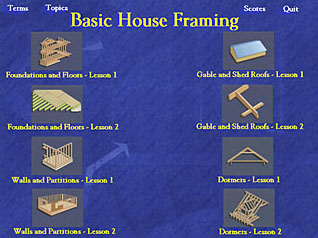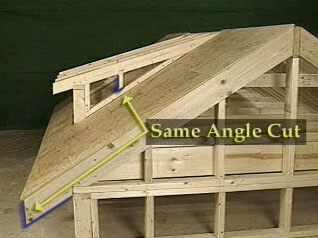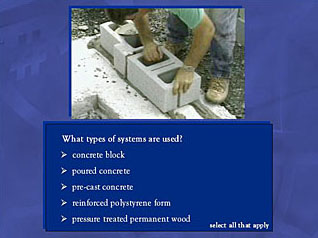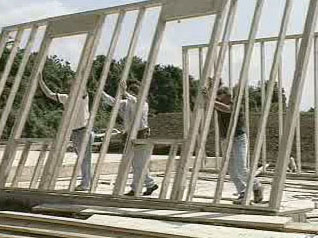Back to Course List
Building: Basic House Framing

- Product ID
- dlmrbhf1
- Training Time ?
- 106 to 159 minutes
- Language(s)
- English
- Video Format
- Standard Definition
- Required Plugins
- MasteryNet Player
- Lesson Interactions
- 20
- Quiz Questions
- 80



Overview
Stressing safety first, this training demonstrates the carpentry fundamentals necessary for the construction of a frame house. Although directed toward instruction for journeymen carpenters and construction supervisors, it will also serve as a valuable reference tool to architectural drafting classes.
![]() This course is in the Advantage™ format, to read about Advantage™ features click here.
This course is in the Advantage™ format, to read about Advantage™ features click here.

- Install on any SCORM LMS
- Rich multimedia presentation with interactions and quiz
- Print certificate and wallet card
- You have 30 days to complete the course
Workplaces
Categories
Audience
Journeymen carpenters and construction supervisors as well as for use in architectural drafting classes.
Topics
The course presents the following topical areas:
-
Foundation and Floors
- Wood frame construction
- Plank and beam
- Conventional
- Balloon framing
- Platform framing
- Studs
- Joists/ribbon board
- Firestops
- Batter boards
- Footings
- Foundation wall systems
- Anchoring methods
- Framing: box sill platform construction
- Anchor bolts
- Termite prevention
- Fiberglass sill sealer
- Joists
- Girder
- Built-up beam
- Splicing
- Girder installation
- Lally column
- Box sill construction (floor joist installation)
- Lap joists and steel I beams
- Cutting joists for openings
- Bridging
- Placement of cross bridging
- Sub floor
-
Walls and Partitions
- Shoe/sole plate, studs, top plate : purpose
- Rough opening: definition
- King, trimmer/jack studs: purpose
- Header: definition and function
- Upper cripples:- definition and location
- Lower cripple
- Rough window opening construction
- Corner wall construction
- Exterior walls
- Partitions: assembing and erecting
- Ceiling joists
-
Gable and Shed Roofs
- Gable, gambrel, hip, mansard and combination
- Parts of roof (ridge, rafter plates, common rafters)
- Roof framing: basic description
- Roof framing: run/rise
- Roof framing: length/span
- Roof framing: pitch/slope
- Rafter cuts (ridge plumb, bird's mouth, overhang, tail)
- Step off method
- Rafter with overhang: birds mouth
- Ridge cut: procedure
- Laying out rafter pattern
- Assembling the roof frame
-
Dormers
- Gable end studs: definition and location
- Determing common distance
- Lookouts: collar beams
- Collar Beam: calculating length
- Shed dormer
- Dormer rafter run
- Dormer rafter top cut
- Stud length
- Gable dormer
- Cripple common rafter and valley rafter
- Main roof dormer valley jacks
- Upper header
Intended Performance Outcomes
Upon successful completion of this course you will be better prepared to:
- Explain the difference between balloon framing and platform framing.
- Explain the purpose of batter boards.
- List the drawings found in a set of working drawings.
-
Explain foundation construction requirements and techniques.
- Identify types of foundations used in residential construction.
- Explain the purpose of footings.
- Identify the sill plate.
- Explain the purpose of the sill plate.
- Explain the purpose of a sill sealer.
- Describe how to prevent termite damage.
- Identify the parts of a floor frame.
-
Explain flooring construction requirements and techniques.
- Explain why and when joists should be doubled.
- Explain the use of bridging.
- Identify laminated veneer lumber floor joists.
- Explain the purpose of girders and beams.
- Describe the proper method to install plywood subfloor.
- List the correct sequence for constructing stair well openings.
- Identify parts of rough window openings.
- Identify parts of a framed wall.
-
Explain outside wall construction requirements and techniques.
- Identify common types of wall studs.
- Describe stud spacing.
- Describe correct positioning of studs over floor joists.
- Explain the purpose of top plates.
- Explain the purpose of a header.
- Identify the location of jack studs.
- Explain the purpose of jack studs.
- Describe how spaces are used in headers.
- Describe the types of corner post assemblies.
- Describe one process for installing wall sheathing.
- Identify types of wall sheathing.
- Explain when ceiling joists can be installed.
- Explain construction differences between bearing and non-bearing walls.
-
Compare specific types of roofs.
- Identify the most common types of roofs.
- Describe the similarities between a gable roof and a gambrel roof.
- Describe the similarities between a hip roof and a mansard roof.
- Identify the various framing members used in roof construction.
- Explain the difference between run and span.
- Explain the relationship between the parts of a gable roof and a right triangle.
-
Discuss specific rafter construction techniques.
- Describe characteristics of good rafter stock.
- Describe the step-off method of laying out a simple common rafter.
- Explain the conditions for shortening rafters at the ridge.
- Describe the purpose of the bird's mouth.
-
Explain unit rise measurements.
- Locate the unit length on the framing square for unit rise measurement.
- Explain when an odd unit will occur.
- Calculate the common difference in length for gable and studs.
- Explain the purpose of a collar beam.
- Calculate the length for a collar beam.
- List purposes of dormers.
- Compare shed and gable dormers.
-
Discuss shed dormer construction calculations.
- Determine the top cut for a shed dormer rafter.
- Determine the run of a shed dormer rafter.
- Determine the top and bottom cut on shed dormer wall studs.
- Calculate the common difference in length for dormer wall studs.
© Mastery Technologies, Inc.



